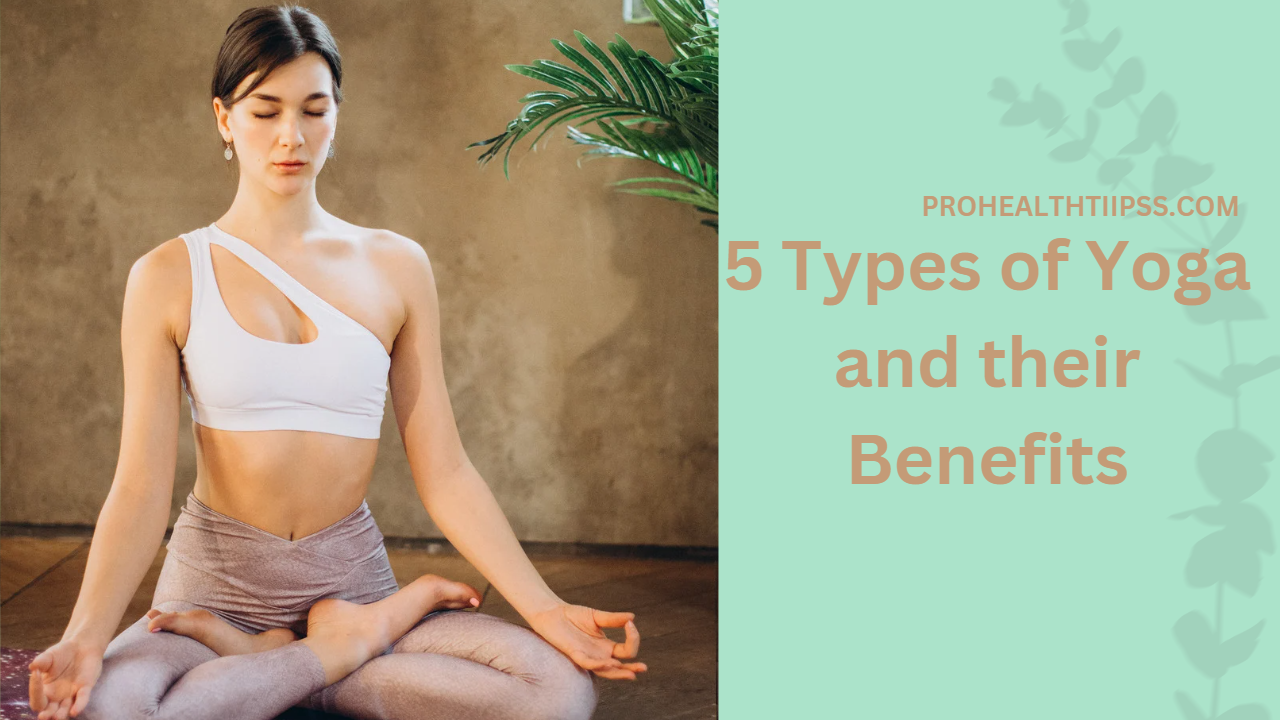5 Types of Yoga and their Benefits
Yoga is a comprehensive discipline that integrates physical postures, breath control, meditation, and ethical principles, offering a holistic approach to well-being. Its roots trace back to ancient India, and over time, it has garnered global recognition due to its wide range of advantages for the body, mind, and spirit. The practice encompasses diverse forms of yoga, each focusing on distinct aspects of the discipline. Let’s explore 5 Types of Yoga and their Benefits.

There are 5 Types of Yoga and their Benefits
Restorative Yoga:-
- Stress Reduction and Relaxation: Restorative Yoga is designed to induce a state of deep relaxation by using props such as blankets, bolsters, and blocks to fully support the body in each pose. This allows for passive stretching and relaxation, helping to release physical and mental tension, and reducing stress levels.
- Calming the Nervous System: The slow-paced nature of Restorative Yoga, coupled with deep, conscious breathing, activates the parasympathetic nervous system, which promotes relaxation, reduces anxiety, and restores balance to the body and mind.
- Improved Sleep Quality: Restorative Yoga can help improve the quality of sleep. The practice prepares the body and mind for rest by soothing the nervous system, relieving physical discomfort, and promoting a sense of calmness, leading to a more restful and rejuvenating sleep.
- Enhancing Body Awareness and Mindfulness: Restorative Yoga encourages individuals to tune into their bodies and become more aware of physical sensations, breath, and mental states. The practice cultivates mindfulness, allowing practitioners to be fully present in the moment and develop a deeper connection with themselves.
- Physical Healing and Recovery: Restorative Yoga is particularly beneficial for those recovering from illness, injury, or experiencing chronic pain. The gentle stretches and supported poses help improve circulation, enhance joint mobility, and promote healing by reducing inflammation and tension in the body.
- Balancing Energy Levels: Restorative Yoga helps restore balance to the body’s energy systems. By allowing the body to rest deeply and promoting relaxation, the practice helps replenish energy levels, reduce fatigue, and improve overall vitality.
- Emotional Well-being: Restorative Yoga provides a nurturing and safe space for emotional healing and stress relief. The practice encourages self-care, self-compassion, and self-reflection, allowing individuals to process and release emotions, fostering emotional well-being.
It’s important to remember that Restorative Yoga is not about achieving challenging poses or exerting effort but rather about surrendering and allowing the body to deeply relax and restore itself. It is suitable for individuals of all fitness levels and can be particularly beneficial for those experiencing high levels of stress, fatigue, or seeking a gentle practice to balance a more active yoga routine.
Hatha Yoga:-
Hatha Yoga foundational style of yoga, offers a range of benefits for both the body and mind. Through the practice of physical postures (asanas) and breath control (pranayama), Hatha Yoga helps develop strength, flexibility, and balance. It reduces stress levels, promotes relaxation, and improves body awareness. The practice increases energy flow, enhances mental clarity and focus, and cultivates a deeper mind-body connection. Overall, Hatha Yoga provides a holistic approach to well-being, fostering physical vitality, mental peace, and a sense of overall harmony.
- Physical Strength and Flexibility: Hatha Yoga helps develop physical strength, flexibility, and balance through various asanas. Regular practice can improve muscle tone, enhance joint mobility, and increase overall flexibility.
- Stress Reduction: The combination of asanas and conscious breathing in Hatha Yoga helps reduce stress levels. The practice encourages deep relaxation and activates the parasympathetic nervous system, promoting a sense of calm and relaxation.
- Improved Body Awareness: Hatha Yoga cultivates body awareness, allowing practitioners to develop a deeper connection with their physical body. This heightened awareness can lead to better posture, alignment, and an improved sense of overall well-being.
- Increased Energy Flow: Through the practice of asanas and breath control, Hatha Yoga aims to stimulate and balance the flow of energy in the body. This can result in increased vitality, improved circulation, and a sense of revitalization.
- Mental Clarity and Focus: Hatha Yoga incorporates mindfulness and meditation techniques, promoting mental clarity and focus. Regular practice can help calm the mind, reduce mental chatter, and enhance concentration and awareness.
- Relaxation and Stress Relief: Hatha Yoga includes relaxation techniques, such as Savasana (Corpse Pose), which provides deep rest and rejuvenation. The practice helps release physical and mental tension, promoting relaxation and stress relief.
- Mind-Body Connection: Hatha Yoga emphasizes the integration of breath, movement, and mindfulness, fostering a stronger mind-body connection. This increased awareness can lead to a greater understanding of oneself and the ability to live in the present moment.

Read More:-Can Power Yoga Help Reduce Body Weight?
Ashtanga Yoga:-
Ashtanga Yoga is a disciplined and physically demanding style of yoga that follows a set sequence of poses. Practicing Ashtanga Yoga offers a wide range of benefits for the body, mind, and spirit. Here are some key benefits of Ashtanga Yoga:
- Strength and Flexibility: Ashtanga Yoga builds strength and tones the muscles throughout the body. The series of dynamic poses and vinyasa flow require physical effort, promoting muscle development and increased flexibility.
- Endurance and Stamina: The rigorous nature of Ashtanga Yoga helps improve cardiovascular endurance and overall stamina. The practice involves continuous movement, synchronized with breath, which challenges the body and builds resilience.
- Cleansing and Detoxification: Ashtanga Yoga incorporates specific breathing techniques, such as Ujjayi breath, which helps generate internal heat and initiate detoxification. Sweating during the practice helps flush out toxins from the body.
- Mental Focus and Concentration: The synchronized breath and precise movements in Ashtanga Yoga require focused attention and concentration. Regular practice can enhance mental clarity, improve concentration, and cultivate a calm and focused mind.
- Discipline and Self-Reflection: Ashtanga Yoga follows a set sequence of poses, providing a structured framework for practice. The discipline required in following the sequence fosters self-discipline and self-reflection, promoting personal growth and self-awareness.
- Stress Reduction: Ashtanga Yoga offers a powerful way to relieve stress and tension. The dynamic movement, breathwork, and mindful focus help release mental and emotional stress, promoting a sense of relaxation and well-being.
- Mind-Body Connection: Ashtanga Yoga emphasizes the integration of breath, movement, and drishti (focused gaze), which helps cultivate a deep mind-body connection. This connection facilitates a sense of presence, awareness, and inner balance.
It’s important to note that Ashtanga Yoga is a physically demanding practice that requires guidance from a qualified instructor, especially for beginners. It is advisable to gradually progress through the practice, respecting the body’s limits, and allowing for proper rest and recovery.
Kundalini Yoga:-
Kundalini Yoga is a spiritual and energetic style of yoga that focuses on awakening the dormant spiritual energy (kundalini) within the body. The practice of Kundalini Yoga offers a range of benefits for physical, mental, and spiritual well-being. Here are some key benefits of Kundalini Yoga:
- Spiritual Growth and Awakening: Kundalini Yoga aims to activate and raise the kundalini energy, which is believed to lead to spiritual awakening and expansion of consciousness. The practice helps individuals connect with their higher selves and explore their spiritual potential.
- Increased Energy and Vitality: Kundalini Yoga involves dynamic movements, breathwork, chanting, and meditation, which help circulate and amplify the energy within the body. Regular practice can increase vitality, boost energy levels, and enhance overall well-being.
- Emotional Balance and Stress Relief: Kundalini Yoga incorporates various techniques to release emotional blockages and reduce stress. The practice includes chanting, mantra repetition, and meditation, which promote emotional balance, relaxation, and a sense of inner peace.
- Improved Physical Strength and Flexibility: Although Kundalini Yoga focuses primarily on spiritual and energetic aspects, it also includes physical postures and movements. Regular practice can improve physical strength, flexibility, and coordination.
- Mindfulness and Presence: Kundalini Yoga cultivates mindfulness and presence by combining movement, breathwork, and meditation. The practice helps individuals develop a deep state of awareness, enhancing focus, concentration, and the ability to live in the present moment.
- Stress Reduction and Relaxation: Kundalini Yoga incorporates specific breathwork techniques that help regulate the nervous system and induce a state of deep relaxation. The practice reduces stress levels, calms the mind, and promotes a sense of inner tranquility.
- Emotional Release and Healing: Kundalini Yoga includes practices that stimulate the release of emotions and facilitate emotional healing. The combination of movement, breathwork, and meditation can help individuals process and release stored emotional energy.
It’s important to note that Kundalini Yoga is a powerful practice that should be approached with respect and under the guidance of a qualified Kundalini Yoga instructor. It is advisable to practice with proper instruction and gradually build up your practice to ensure safety and optimal benefit.

Bikram Yoga:-
Bikram Yoga, also known as hot yoga, is a style of yoga that consists of a series of 26 poses and two breathing exercises, all practiced in a heated room. The unique environment of Bikram Yoga offers several benefits for the body, mind, and overall well-being. Here are some key benefits of practicing Bikram Yoga:
- Increased Flexibility: The heat in the Bikram Yoga room helps warm up the muscles, making them more pliable and flexible. This can lead to improved range of motion and increased flexibility over time.
- Detoxification: The heat and intense practice of Bikram Yoga encourage sweating, which aids in detoxification. Sweating helps flush out toxins from the body, promoting a sense of cleansing and rejuvenation.
- Improved Strength and Endurance: Bikram Yoga involves holding poses for an extended period, which can build strength and endurance. The repeated practice of the 26 poses works various muscle groups, leading to increased overall strength.
- Enhanced Cardiovascular Health: The combination of the heated environment and the dynamic nature of the practice in Bikram Yoga can provide a cardiovascular workout. The increased heart rate and blood circulation promote cardiovascular health and improve stamina.
- Mental Focus and Stress Relief: The heat and challenging nature of Bikram Yoga require concentration and mental focus. The practice encourages mindfulness, helping to quiet the mind and reduce stress. It can provide a space for individuals to detach from external distractions and focus on the present moment.
- Improved Breathing and Lung Capacity: The breathing exercises incorporated in Bikram Yoga can enhance lung capacity and improve respiratory function. The practice emphasizes deep, controlled breathing, which can have a positive impact on overall breathing patterns and oxygenation.
It’s important to approach Bikram Yoga with caution and listen to your body. The high heat and demanding nature of the practice may not be suitable for everyone, particularly individuals with certain health conditions or sensitivities to heat. It’s advisable to consult with a healthcare professional and practice under the guidance of a qualified Bikram Yoga instructor to ensure safety and maximize the benefits of the practice.





[…] If you know about 5 Types of Yoga and their Benefits,then CLICK HERE […]
[…] If you know about Yoga and their Benefits must read this article Click Here […]
[…] mind, spirit and body. Its roots are thousands of years old in India and are continuing till now.Yoga has so much power that it helps in controlling the breath, and along with it it also includes […]
[…] Also Read this Article Can Power Yoga Help Reduce Body Weight Click Here Also Read this Article 5 Types of Yoga and their Benefits Click Here […]